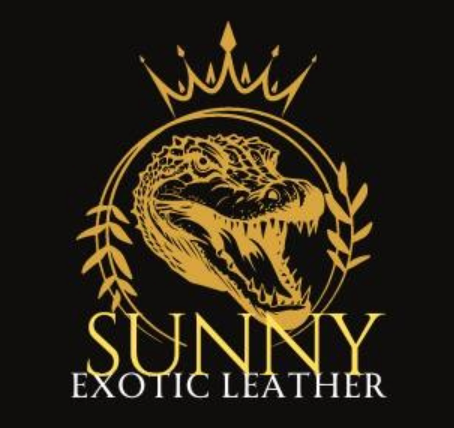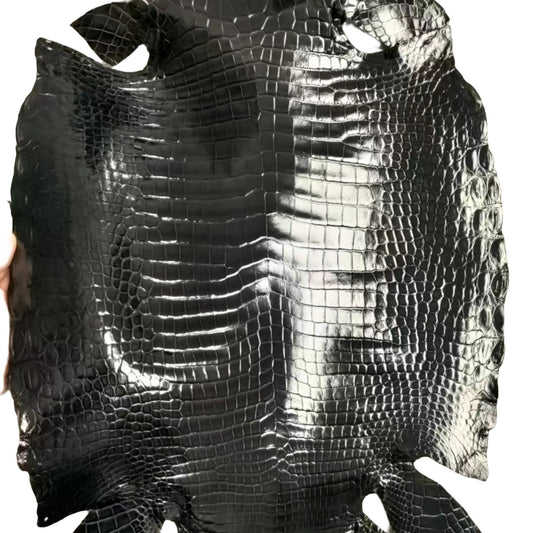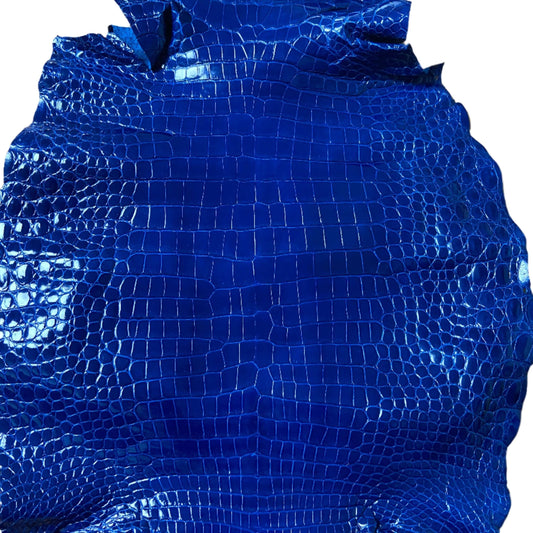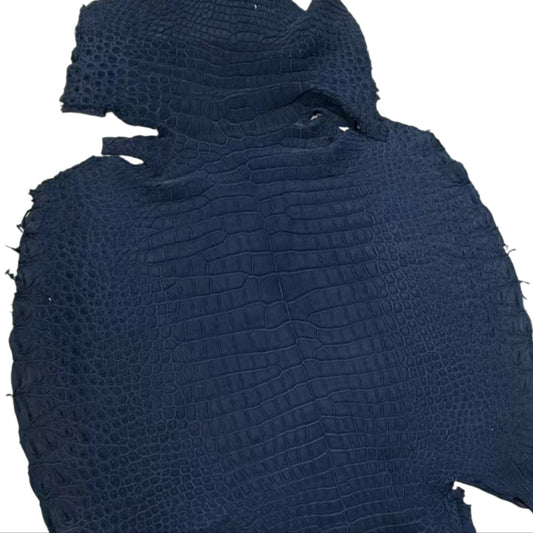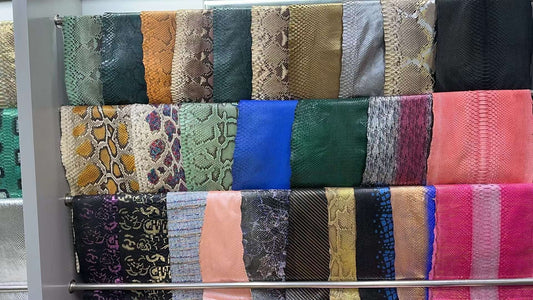ワニ皮について知っておくべきこと
共有
ワニ革のご紹介: あなたのワードローブのための時代を超えた素材。

ワニ皮は、ハンドバッグ、履物、時計バンド、衣類、ベルト、財布など、さまざまな高級皮革製品やアクセサリーに使用されてきた長い歴史があります。アメリカ南東部原産のアメリカワニは、これらの人気の皮革の原料です。これらの動物は野生捕獲と養殖の両方が可能で、各州の魚類野生生物局による厳しい規制により、持続可能な慣行が確保されています。
何世紀にもわたり、ワニ皮は耐久性と美しさから採取されてきました。1800 年代初頭、ワニ皮はブーツ、靴、鞍の製造や、蒸気機関や綿糸工場の潤滑油として使われていました。1800 年代後半から 1900 年代初頭にかけて商業的ななめし加工法が発見されてから、ワニ革はよりしなやかで柔らかくなり、需要が急増しました。残念ながら、この需要の急増によりワニの個体数は減少し、1962 年に狩猟は禁止されました。
しかし、ルイジアナ州ロックフェラー保護区で画期的なワニ養殖プログラムが立ち上げられたことで、ワニの個体数は回復し、1987年に絶滅危惧種リストから除外されました。このプログラムは、世界中で同様の変化を起こすための例となり、毎年、ワニ類全体の3分の1が適切に管理されて捕獲され、他の多くの種の保護状況も改善されました。
当社のオンライン ストアでは、商業用ワニ皮なめしの歴史を尊重するベスト プラクティスを使用してなめされた、倫理的かつ持続可能な方法で調達されたワニ皮を誇りを持って提供しています。品質へのこだわりにより、当社は世界でも数少ない独立したワニ皮なめし業者の 1 つとなり、お客様は高級レザーのニーズを満たすために当社で買い物を続けています。
時代を超えたワニ皮の優雅さをぜひご体験ください。洗練された雰囲気でワードローブをグレードアップしましょう。
ワニ皮の特徴
アメリカワニの皮は、他の種類のワニ皮のような毛包模様がなく、中~大型の腹部の鱗を持っています。毛包模様がなく、カルシウム含有量が比較的低いため、鱗は滑らかに見えます。他のほとんどのワニ種よりも脇腹部分が大きく、腹部は狭くなっています。尾も、同様のサイズのワニ種の平均よりも幅広です。
パンナムレザーズ ワニ皮のグレード 腹部と脇腹を含む胴体部分のみ。頭部と尾部の状態は等級付けに考慮されません。等級は次のように定義されます。
- グレード1: 腹部に欠陥なし
- グレード2: 腹部または側腹部の外縁に欠陥が1つ集中している
- グレード3: 腹部中央部に欠陥が1つ集中している
- グレード4: 中央部の2つの異なる象限に欠陥が集中している
- グレード5: グレード4よりも悪い
欠陥は、ほとんどの場合、傷跡、引っかき傷、陰影、または鱗状の変形です。まれに、欠陥に穴や木目の問題が含まれる場合があります。穴や木目の問題があるものは、せいぜいグレード 4 に格下げされます。グレード 3 以上のスキンは、中央部に穴や木目の問題がありません。
ワニ皮のサイズ 腹部の最も広い部分で、硬い骨を除いた長さを cm 単位で計測します。以下は、各サイズ カテゴリの皮膚の各部分の平均寸法です。平均厚さ (mm) を除き、すべての測定値は cm 単位です。
|
サイズ範囲 |
20/24センチ |
25/29センチ |
30/34センチ |
35/39センチ |
40/44センチ |
45/49センチ |
50/54センチ |
55/59センチ |
60/64センチ |
|
頭の幅 |
15 |
20 |
25 |
25 |
27 |
32 |
29 |
29 |
31 |
|
頭の長さ |
15 |
20 |
30 |
25 |
30 |
35 |
34 |
34 |
39 |
|
腹の幅 |
22 |
27 |
32 |
37 |
42 |
47 |
52 |
57 |
62 |
|
腹の長さ |
19 |
30 |
35 |
35 |
36 |
36 |
39 |
42 |
45 |
|
尾部上部の幅 |
17 |
20 |
24 |
27 |
29 |
33 |
37 |
41 |
44 |
|
尾の長さ |
43 |
50 |
65 |
70 |
85 |
90 |
94 |
98 |
108 |
|
全長 |
88 |
100 |
150 |
155 |
168 |
178 |
180 |
182 |
197 |
|
平均厚さ(mm) |
0.8 |
0.8 |
1 |
1.3 |
1.3 |
1.4 |
1.5 |
1.6 |
1.8 |
ワニ皮の一般的な用途
ワニ革にはさまざまなサイズと品質があり、製品用途の点で非常に用途の広い素材となっています。以下は、さまざまなサイズとグレードのワニ革が一般的にどのように使用されているかをまとめた表です。ただし、プロジェクトや顧客ごとに好みや要件が異なるため、以下はあくまでもガイドとしてご利用ください。
|
CMサイズ範囲 |
グレード2以上 |
グレード3以上 |
グレード5以上 |
|
20/24 |
時計バンド |
時計バンド |
革小物、ジュエリー |
|
25/29 |
時計バンド |
時計バンド |
革小物、ジュエリー |
|
30/34 |
小型ハンドバッグ、履物 |
履物、財布、電子機器アクセサリー |
トリム、革小物 |
|
35/39 |
中型ハンドバッグ、衣類 |
履物、電子機器アクセサリー |
革小物、トリム |
|
40/44 |
中型ハンドバッグ、衣類 |
中型ハンドバッグ、靴 |
ベルト、革小物、トリム |
|
45/49 |
大型ハンドバッグ、衣類 |
衣類、履物、室内装飾品、ベルト |
履物、ベルト、革小物、装飾品 |
|
50/54 |
大型ハンドバッグ、衣類、室内装飾品 |
衣類、履物、室内装飾品、ベルト |
履物、ベルト、革小物、装飾品 |
|
55/59 |
大型ハンドバッグ、衣類、室内装飾品 |
衣類、履物、室内装飾品、ベルト |
ベルト、室内装飾品 |
|
60歳以上 |
荷物、室内装飾品 |
荷物、室内装飾品 |
ベルト、室内装飾品 |

